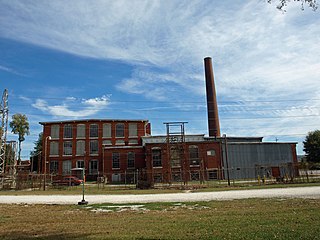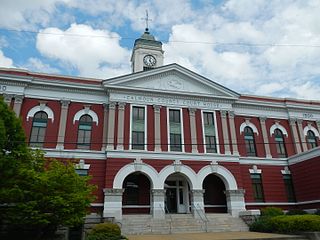
Dallas Mill was a manufacturer of cotton sheeting in Huntsville, Alabama, United States. The first of four major textile mills in Huntsville, the mill operated from 1891 until 1949, before it was converted for use as a warehouse in 1955 and burned in 1991. The village, constructed to house workers and their families, was incorporated into the city in 1955. The mill and its mill village are listed on the National Register of Historic Places.

Harmony Mills, in Cohoes, New York, United States, is an industrial district that is bordered by the Mohawk River and the tracks of the former Troy and Schenectady Railroad. It was listed as Harmony Mills Historic District on the National Register of Historic Places in 1978. A portion of the district encompassing the industrial buildings and some of the housing built for millworkers was declared a National Historic Landmark in 1999. The centerpiece building, Harmony Mill No. 3 was listed on the National Register of Historic Places in 1971.

Grace Episcopal Church, located at 1000 Leighton Avenue in Anniston, Alabama, is an historic Gothic Revival church that was added to the National Register of Historic Places on November 3, 1985.

The Hope Village Historic District is a historic rural mill settlement within Hope Village in Scituate, Rhode Island. Hope Village is located on a bend in the North Pawtuxet River in the southeastern corner of Scituate. Industrial activity has occurred in Hope Village since the mid-eighteenth century. Surviving industrial and residential buildings in the Historic District date back to the early 19th century. The village center sits at junction of Main Street and North Road. Hope Village radiates out from the center with houses on several smaller side streets in a compact configuration. Currently there is little commercial or industrial activity in Hope Village and none in the Historic District. The present stone mill building on the south side of Hope Village was built in 1844 by Brown & Ives of Providence, expanded in 1871 and modified in 1910. Approximately one quarter of the village's current housing stock was built as mill worker housing by various owners of Hope Mill.

Lowe Mill is a former cotton mill of approximately 171,000 sq ft (15,900 m2) located southwest of downtown Huntsville, Alabama.

The Elliottville Lower Mill, also known historically as the Peep Toad Mill, is an historic cotton mill in the East Killingly section of Killingly, Connecticut. Built about 1850, it is a well-preserved example of an early wood-frame textile mill. The mill complex, which includes, a dam, pond, head race, and bridge, was listed on the National Register of Historic Places in 1982.

The Old Colony Iron Works-Nemasket Mills Complex is a historic industrial site located on Old Colony Avenue in the East Taunton section of Taunton, Massachusetts, United States, adjacent to the Taunton River at the Raynham town line. The site was first occupied by the Old Colony Iron Company, which had originally been established in the 1820s as Horatio Leonard & Company. The western part of the complex was sold to Nemasket Mills in 1889. The eastern part was acquired by the Standard Oil Cloth Company. The site was added to the National Register of Historic Places in 1984.

The Whittenton Mills Complex is a historic textile mill site located on Whittenton Street in Taunton, Massachusetts, on the banks of the Mill River. The site has been used for industrial purposes since 1670, when James Leonard built an iron forge on the west bank of the river. The first textile mill was built in 1805 and expanded throughout the 19th century. The complex was added to the National Register of Historic Places in 1984, and now contains various small businesses.

The Johnson Manufacturing Company was a historic mill complex at 65 Brown Street in North Adams, Massachusetts. Developed beginning in 1872 and enlarged through the early 20th century, it was at the time of its 1985 listing on the National Register of Historic Places a well-preserved example of late 19th century industrial architecture, used for the production of textiles for many years. The complex was demolished in 2007.

Mount Zion Baptist Church is a historic church at 212 Second Street in Anniston, Alabama. It was built in 1890 and added to the National Register of Historic Places in 1985.

Parker Memorial Baptist Church is a historic Southern Baptist church at 1205 Quintard Avenue in Anniston, Alabama. Built in 1888, it was added to the Alabama Register of Landmarks and Heritage in 1981, and the National Register of Historic Places in 1985.

Saint Paul's Methodist Episcopal Church is a historic Methodist church building at 1327 Leighton Avenue in Anniston, Alabama. It was built in 1888 and added to the National Register in 1985.

Temple Beth-El is a historic Jewish synagogue at 301 E. Thirteenth Street in Anniston, Alabama. It was built in 1891 in the Romanesque Revival style. It was added to the National Register of Historic Places in 1985.

The Calhoun County Courthouse is a historic county courthouse in Anniston, Alabama. It was designed by Atlanta architect J. W. Golucke and built in 1900, when the county seat of Calhoun County was moved from Jacksonville. It is one of the earliest Neoclassical courthouses in Alabama. An annex with a jail was added on the north side of the building in 1924. The courthouse was rebuilt after a 1931 fire, albeit with a slightly different clock tower. A southeastern annex was built in 1963. The building was listed on the National Register of Historic Places in 1985.

The Cocheco Mills comprise a historic mill complex in the heart of Dover, New Hampshire. The mills occupy a bend in the Cochecho River that has been site of cotton textile manufacturing since at least 1823, when the Dover Manufacturing Company supplanted earlier sawmills and gristmills. The present mill buildings were built between the 1880s and the early 20th century, and were listed on the National Register of Historic Places in 2014.

Oakdale Cotton Mill Village is a historic textile mill, mill village, and national historic district located at Jamestown, Guilford County, North Carolina, United States. The district encompasses 37 contributing buildings including the Logan Manufacturing Company complex built during the 1880s and 33 frame mill worker houses dated to the early-20th century. The factory complex consists of a three-story rectangular brick office, a one and two-story L-shaped brick factory with a four-story tower and five one-story brick warehouses, a small one-story board-and-batten blacksmith shop, and a polygonal brick smokestack.

The Coleman-Franklin-Cannon Mill is a historic industrial complex at 625 Main Street SW in Concord, North Carolina. The recognized complex consists of ten buildings on 6.6 acres (2.7 ha), about 2 miles (3.2 km) west of downtown Concord. Another 4.4 acres are not included. The oldest portion of the mill, now its eastern section, is a brick two-story structure 14 bays long and 9 deep. The historic site also includes some worker housing.

The Glen Addie Volunteer Hose Company Fire Hall, at Fourth St. and Pine Ave. in Anniston, Alabama, was built in 1885. It was listed on the National Register of Historic Places in 1985.

The Daniel Pratt Cotton Gin Manufactory was a cotton gin factory created by Daniel Pratt in 1854, in what is now Prattville, Alabama, a town named for him. The factory became the largest cotton gin machinery factory in the world and supplied cotton gins to all cotton producing countries.

Kilby House, at 1301 Woodstock Ave. in Anniston, Alabama, was built in 1914. It was listed on the National Register of Historic Places in 1985.






















